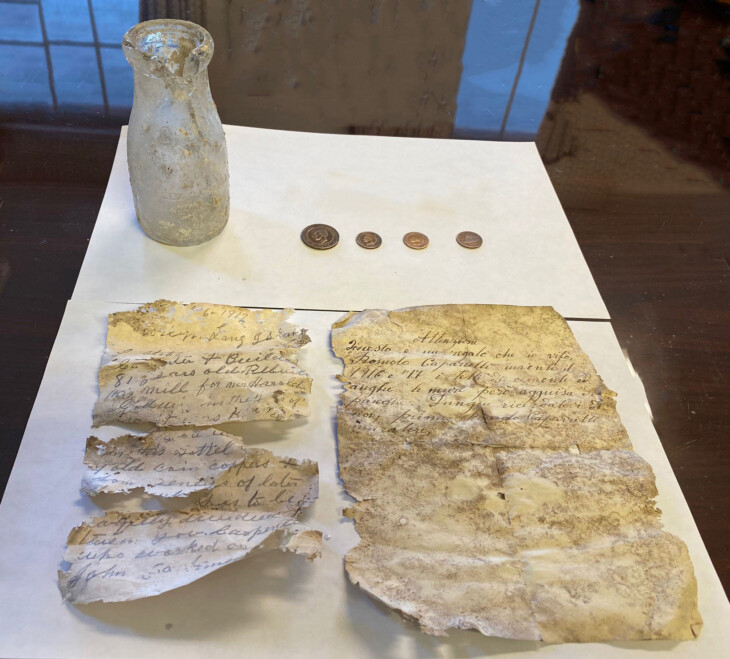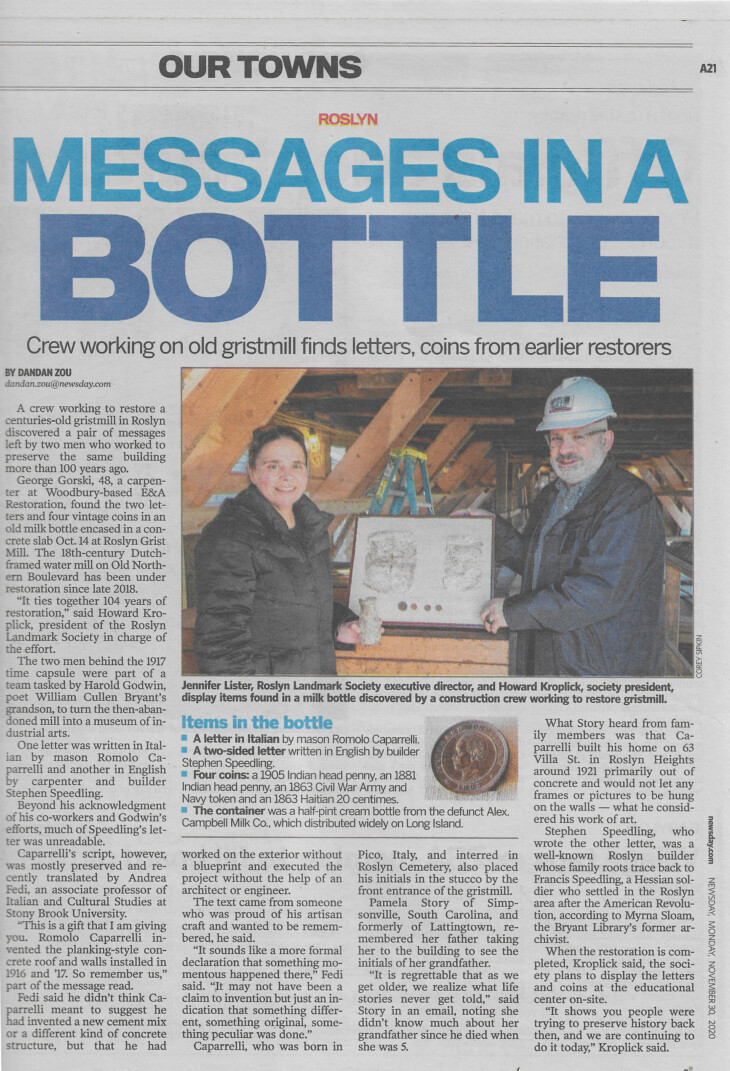At historic Roslyn Grist Mill, an unearthed bottle spills out links to the past
By Dandan Zou
Updated November 29, 2020 6:00 AM
A crew working to restore a centuries-old gristmill in Roslyn discovered a pair of messages left by two men who worked to preserve the same building more than 100 years ago.
George Gorski, 48, a carpenter at Woodbury-based E&A Restoration, found the two letters and four vintage coins in an old milk bottle encased in a concrete slab Oct. 14 at Roslyn Grist Mill. The 18th-century Dutch-framed water mill on Old Northern Boulevard has been under restoration since late 2018.
"It ties together 104 years of restoration," said Howard Kroplick, president of the Roslyn Landmark Society in charge of the effort.
The two men behind the 1917 time capsule were part of a team tasked by Harold Godwin, poet William Cullen Bryant’s grandson, to turn the then-abandoned mill into a museum of industrial arts.
One letter was written in Italian by mason Romolo Caparrelli and another in English by carpenter and builder Stephen Speedling.

Beyond his acknowledgment of his co-workers and Godwin’s efforts, much of Speedling’s letter was unreadable.
Caparrelli’s script, however, was mostly preserved and recently translated by Andrea Fedi, an associate professor of Italian and Cultural Studies at Stony Brook University.
"This is a gift that I am giving you. Romolo Caparrelli invented the planking-style concrete roof and walls installed in 1916 and ’17. So remember us," part of the message read.
Fedi said he didn’t think Caparrelli meant to suggest he had invented a new cement mix or a different kind of concrete structure, but that he had worked on the exterior without a blueprint and executed the project without the help of an architect or engineer.
The text came from someone who was proud of his artisan craft and wanted to be remembered, he said.
"It sounds like a more formal declaration that something momentous happened there," Fedi said. "It may not have been a claim to invention but just an indication that something different, something original, something peculiar was done."
Caparrelli, who was born in Pico, Italy, and interred in Roslyn Cemetery, also placed his initials in the stucco by the front entrance of the gristmill.
Pamela Story of Simpsonville, South Carolina, and formerly of Lattingtown, remembered her father taking her to the building to see the initials of her grandfather.

"It is regrettable that as we get older, we realize what life stories never get told," said Story in an email, noting she didn’t know much about her grandfather since he died when she was 5.
What Story heard from family members was that Caparrelli built his home on 63 Villa St. in Roslyn Heights around 1921 primarily out of concrete and would not let any frames or pictures to be hung on the walls — what he considered his work of art.
Stephen Speedling, the man who wrote the other letter, was a well-known Roslyn builder whose family roots can be traced back to Francis Speedling, a Hessian soldier who settled in the Roslyn area after the American Revolution, according to Myrna Sloam, the Bryant Library’s former archivist.

When the restoration is completed, Kroplick said, the society plans to display the letters and coins at the educational center on-site.
"It shows you people were trying to preserve history back then, and we are continuing to do it today," Kroplick said.


3 Comments
Howard, as Linda and I were discussing this, we both thought we'd seen a reference to Caparrelli sealing a bottle into the foundation -- also, some frogs! Maybe a Stuart Donaldson reminiscence. Check the Bryant Library. Of course, I don't have my old files to check.
Terry, I also found a note in the Roslyn Landmark Society archives concerning Caparrelli's RC initials on the outside of the building.
Good. I saw that you were aware of the initials and was relieved -- I always worried that they might be destroyed by accident.
one of these days we have to visit the mill together. I have stories to share!
Terry, really looking forward to that day!
Thanks, Howard, me too!
Fascinating account--with great information about the landscape architect in the AR essay. Despite the French architecture of White the landscape by Guy Lowell is described as American--featuring newly planted 25 ft Maple trees instead of European evergreens. It is "informal" and "natural." I am having trouble bring up Part II.
General John J. Pershing. Lived in Roslyn for a short time. His brother James was a Roslyn resident.
In the Old World tradition of artists signing their work, Invenit, Romolo Caparelli invented the planking style concrete roof and walls for the Roslyn Grist Mill. When he wrote his message in a bottle: "This is a gift that I am giving you. Romolo Caparrelli invented the planking-style concrete roof and walls installed in 1916 and 17. So remember us.", he was working as a mason at one of the most exciting moments in architectural history as concrete construction techniques were being invented and patented. Mr. Caparellis Roslyn Heights home ca. 1921 and the 1908 home designed by Frederick J. Sterner, 17 The Intervale (profiled in this weeks Roslyn Landmark Society Newsletter), are examples of concrete construction on LI as improved roads and the auto brought Roslyn within a 35 min. ride of NYC. In Suffolk, Smithtown was a one hour and 35 minute-drive via the Vanderbilt Motor Parkway, according to the Parkways lead planner, A.R. Pardington when he moved to Smithtown. A.R.s colleague Fred Wagner, famous Vanderbilt Cup Race starter, also moved to Smithtown, and commissioned Gustav Stickley to be architect of his concrete home, built in 1912. Wagner introduced Stickley -- the American Arts and Crafts leader who had been promoting concrete construction for years -- to his former New Rochelle neighbor Will H. Van Guilder, who first applied for a patent for his hollow wall concrete construction method a few months after Freds house was built using it. The Frederick and Annie Wagner Residence (National Register, 2019: see https://www.vanderbiltcupraces.com/blog/article/the_residence_of_the_starter_of_five_vanderbilt_cup_races_rediscovered_in_s ) is the only documented example in the United States of a Stickley design using the Van Guilder process of hollow concrete wall construction, which created an envelope of insulating space like a thermos-bottle. First used as early as 1908 with molding machines, patented in 1911, to pour the concrete on site; the Van Guilder process was patented in 1916 at about the time Romolo Caparelli wrote his note encased in a concrete slab and placed his initials in the stucco at the Roslyn Grist Mill, putting his name to his enduring work of art.
Caparelli was the master craftsman behind the concrete sheathing of the mill, but the concept almost certainly came from Harold Godwin, who bankrolled the project. After fire almost destroyed Cedarmere (which Godwin owned) in 1902, Godwin rebuilt it using concrete and started utilizing concrete on multiple projects.
Jason, excellent question. We will check with our architect and foundation supervisor for the answers.
A thank you to the entire Roslyn Landmark Society. So appreciated